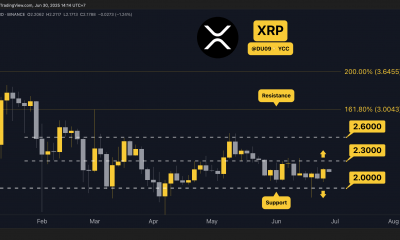Forex
Eurozone GDP growth estimate raised to 0.3% in Q3

The Eurozone GDP economy in 19 countries increased by 0.3% in Q3 compared to the previous quarter, final data from the EU Statistical Office showed. An increase of 0.2% was previously reported, and analysts on average did not expect to revise that estimate, according to Trading Economics.
Eurostat Eurozone GDP – current data
On an annualized basis, Eurozone GDP rose by 2.3% in July-September, not 2.1% as previously reported. In the 2nd quarter of this year, Eurozone GDP growth was 0.8% quarter-on-quarter and 4.1% year-on-year. This news had a positive effect on the current Euro Bund situation.
The GDP of the 27 EU nations grew 0.4% quarter over quarter in Q3, following a 0.7% increase in the previous quarter. Growth in annual terms was 2.5%.
The highest quarter-on-quarter growth was seen in Ireland (2.3%), Cyprus, Malta, and Romania (1.3%). The largest decrease was observed in Estonia (-1.8%), Latvia (-1.7%) and Slovenia (-1.4%).
Consumer spending in the euro area in the 3rd quarter grew by 0.9% relative to the 2nd quarter, in the EU – by 0.7%.
The volume of exports from the euro area increased by 1.7%, from the EU – by 1.9%. Imports increased by 3.4% in the euro area and by 3.2% in the EU.
The Eurostat report also includes data on the dynamics of employment in the euro area and the EU in Q3. According to the final data, the number of employed people increased by 0.3% in the euro area and by 0.2% in the EU compared to the previous quarter.
Germany’s quarterly GDP growth accelerated to 0.4% after rising 0.1% in Q2, France slowed to 0.2% from 0.5%; Italy to 0.5% from 1.1%, and Spain to 0.2% from 1.5% a quarter earlier.
Earlier, we reported that the dollar was appreciating against most currencies on December 7.

 Forex3 years ago
Forex3 years agoForex Today: the dollar is gaining strength amid gloomy sentiment at the start of the Fed’s week

 Forex3 years ago
Forex3 years agoUnbiased review of Pocket Option broker

 Forex3 years ago
Forex3 years agoDollar to pound sterling exchange rate today: Pound plummeted to its lowest since 1985

 Forex3 years ago
Forex3 years agoHow is the Australian dollar doing today?

 Cryptocurrency3 years ago
Cryptocurrency3 years agoWhat happened in the crypto market – current events today

 World3 years ago
World3 years agoWhy are modern video games an art form?

 Commodities3 years ago
Commodities3 years agoCopper continues to fall in price on expectations of lower demand in China

 Economy3 years ago
Economy3 years agoCrude oil tankers double in price due to EU anti-Russian sanctions



























